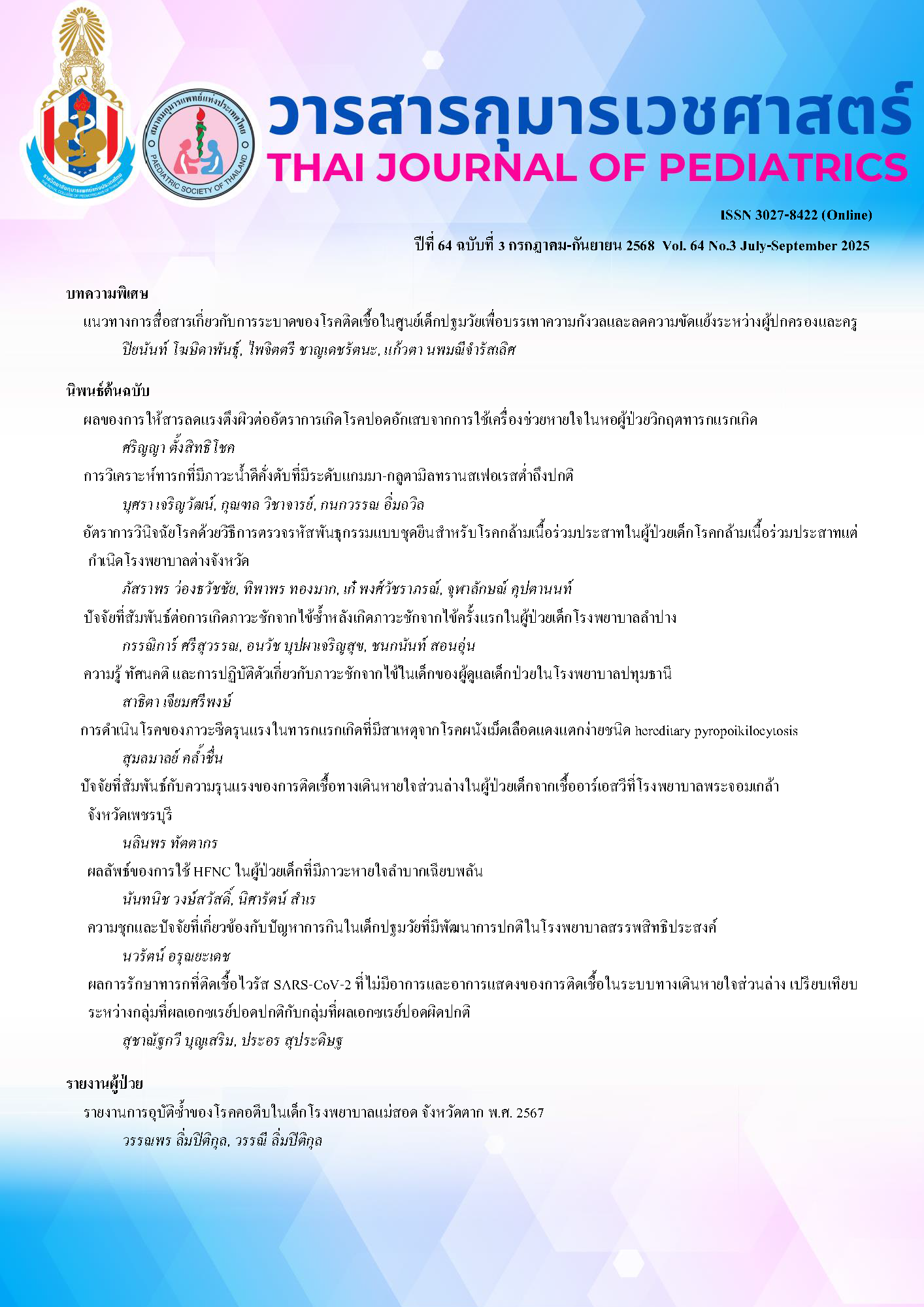Prevalence and associated factors of feeding difficulties in typically developing preschool children in Sunprasitthiprasong Hospital
Keywords:
Feeding difficulties, Typically Developing Preschool Children, Preterm birth, Screen media use during meals, Sociodemographic factorsAbstract
Background: Feeding difficulties in early childhood are common and can adversely affect growth, nutrition, and long-term health. Despite global data, local epidemiological evidence in Thailand particularly among typically developing preschool children remains limited, and potential modifiable factors have not been thoroughly explored.
Objectives: To determine the prevalence of feeding difficulties and identify associated sociodemographic and behavioral factors among typically developing preschool children.
Methods: A prospective study was conducted among 385 children aged 6 months–6 years attending the outpatient department of Sunpasitthiprasong Hospital, Ubon Ratchathani. Feeding behavior was assessed using the Thai version of the Montreal Children’s Hospital Feeding Scale (MCH-FS-TH), validated for psychometric properties. Statistical analyses included descriptive statistics, Pearson’s Chi-square test, and multivariable logistic regression to identify independent predictors of feeding difficulties.
Results: The prevalence of feeding difficulties was 31.9%. Multivariable analysis revealed that preterm birth (adjusted odds ratio [AOR] = 2.09, 95% CI: 1.05–4.19) and screen media use during meals (AOR = 2.30, 95% CI: 1.31–4.02) significantly increased the likelihood of feeding difficulties. Low weight-for-age (≤3rd percentile) showed a borderline association (AOR = 1.98, 95% CI: 0.98–3.99). No significant associations were found with parental education or family income.
Conclusions: Feeding difficulties affect nearly one-third of typically developing preschoolers in this Thai cohort, with preterm birth and screen media use during meals emerging as key modifiable risk factors. These findings highlight the need for targeted parental guidance and early interventions, particularly discouraging screen use during meals and providing closer feeding behavior monitoring for preterm children.
Downloads
References
จัณท์ฑิตา พฤกษานานนท์. ปัญหาการกิน. ใน: ทิพวรรณ หรรษาคุณาชัย, รวิวรรณ รุ่งไพรวัลย์, บรรณาธิการ. ตำราพัฒนาการและพฤติกรรมเด็ก. กรุงเทพมหานคร: บียอนด์ เอนเทอร์ไพรซ์; 2011. หน้า 170–1.
Yang HR. How to approach feeding difficulties in young children. Korean J Pediatr. 2017;60:379–84.
Benjasuwantep B, Chaithirayanon S, Eiamudomka. Feeding problems in healthy young children: Prevalence, related factors and feeding practices. Pediatr Rep. 2013;5:e38–42.
Carruth BR, Ziegler PJ, Gordon A, Barr SI. Prevalence of picky eaters among infants and toddlers and their caregivers' decisions about offering a new food. J Am Diet Assoc. 2004;104:57–64.
Hasbani EC, Silva LBD, Silveira TRD, Gomes LM, Bueno NB, Leal VS. How parents' feeding styles, attitudes, and multifactorial aspects are associated with feeding difficulties in children. BMC Pediatr. 2023;23:543.
Kerzner B. Clinical investigation of feeding difficulties in young children: A practical approach. Clin Pediatr (Phila). 2009;48:960–5.
Cengiz G, Süleyman Y, Oya BH. Eating behaviors in early childhood (1–5 years) and their association with sociodemographic characteristics in Turkey. Cureus. 2021;13:e16876.
Pongpaothai N, Chunsuwan I, Hansakunachai T. Prevalence of eating behavioral problems among children aged 1–6 years in perimeter province of Bangkok, Thailand. Thai J Pediatr. 2004;53:181–8.
Chunsuwan I, Ma-eime W, Hansakunachai T, Kulalert P, Lerthattsilp T. Feeding problems of preschool-age children with autism spectrum disorder in Pathum Thani province, Thailand. Asian Med J Altern Med. 2021;21:199–209.
Sullivan PB, Lambert B, Rose M, Ford-Adams M, Johnson A, Griffiths P. Prevalence and severity of feeding and nutritional problems in children with neurological impairment: Oxford feeding study. Dev Med Child Neurol. 2000;42:674–80.
Ledford JR, Gast DL. Feeding problems in children with autism spectrum disorders: A review. Focus Autism Other Dev Disabil. 2006;21:153–66.
Linscheid T, Budd K, Rasnake L. Pediatric feeding problems. In: Roberts MC, editor. Handbook of pediatric psychology. New York: Guilford Press. 2003. p.481–9.
Baird J, Fisher D, Lucas P, Kleijnen J, Roberts H, Law C. Being big or growing fast: Systematic review of size and growth in infancy and later obesity. BMJ. 2005;331:929.
Kerzner B, Milano K, MacLean WC Jr, Berall G, Stuart S, Chatoor I. A practical approach to classifying and managing feeding difficulties. Pediatrics. 2015;135:344–53.
งามจรัส ชัยศิริ, ศรีสถิตย์วัฒนา สวิทยา, บุญยะรัตน์ สุวรรณา. ชีวสถิติและระเบียบวิธีวิจัย. ขอนแก่น: ภาควิชาชีวสถิติและประชากรศาสตร์ คณะสาธารณสุขศาสตร์ มหาวิทยาลัยขอนแก่น; 2561.
Benjasuwantep B, Rattanamongkolgul S, Ramsay M. The Thai version of the montreal children's hospital feeding scale (MCH-FS): Psychometric properties. J Med Assoc Thai. 2015;98:163–9.
Teekavanich S, Rukprayoon H, Sutchritpongsa S, Rojmahamongkol P. Electronic media use and food intake in Thai toddlers. Appetite. 2022;176:106121.
Kamity R, Kapavarapu PK, Chandel A. Feeding Problems and long term outcomes in preterm infants—A systematic approach to evaluation and management. Children (Basel). 2021;8:1158.
Jensen ML, Dillman Carpentier FR, Corvalán C, Popkin BM, Evenson KR, Adair L, et al. Television viewing and using screens while eating: Associations with dietary intake in children and adolescents. Appetite. 2021;168:105670.
Downloads
Published
How to Cite
Issue
Section
License
Copyright (c) 2025 The Royal College of Pediatricians Of Thailand

This work is licensed under a Creative Commons Attribution-NonCommercial-NoDerivatives 4.0 International License.



